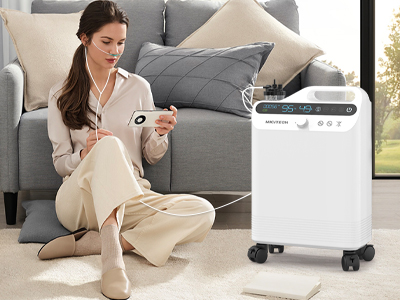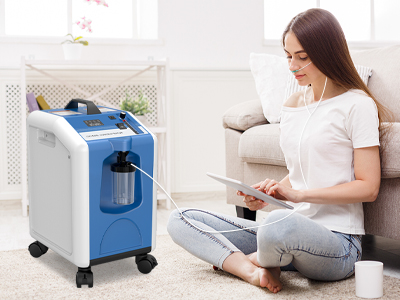03 Nov 2023
Oxygen is a fundamental element in medical therapy, providing life-sustaining support to individuals with respiratory conditions and other health concerns. The question that often arises is whether an oxygen concentrators, a device designed to generate oxygen, is as effective as medical-grade oxygen itself.
The Vital Role of Oxygen in Medical Therapy
Oxygen concentrators are innovative medical devices that draw in ambient air, remove impurities, and supply a concentrated stream of oxygen to patients in need.

Oxygen Concentrators: How They Work
A. Oxygen Concentration Mechanism Oxygen concentrators operate by the principle of pressure swing adsorption (PSA). This mechanism involves the filtration of nitrogen and other gases from the surrounding air, leaving behind high-purity oxygen for the patient.
B. Components of an Oxygen Concentrator 1. Air Inlet The concentrator begins its process by drawing in room air through an air inlet, ensuring a continuous supply of air. 2. Compressor A compressor pressurizes the incoming air, preparing it for filtration and the subsequent extraction of oxygen. 3. Sieve Beds Sieve beds are essential components that trap nitrogen and other gases, allowing only oxygen to pass through. 4. Oxygen Outlet The purified oxygen is directed to the patient through the oxygen outlet, ready for therapeutic use.

Purity of Oxygen: Concentrator vs. Medical Oxygen
A. Defining Oxygen Purity Oxygen purity refers to the concentration of oxygen in the air delivered to the patient. High-purity oxygen is essential for effective therapy.
B. Comparing Oxygen Purity Levels 1. Concentrator-Generated Oxygen Oxygen concentrators are designed to provide oxygen with purity levels typically ranging from 87% to 95%. While this purity is suitable for most patients, it may not meet the standards required for certain medical applications. 2. Medical Oxygen Cylinders Medical-grade oxygen cylinders offer higher purity levels, often exceeding 99%. They are indispensable for critical medical procedures and patients with specific oxygen requirements.
Flow Rate and Oxygen Therapy
A. Flow Rate Adjustability One of the strengths of oxygen concentrators is their adjustability. Users can modify the flow rate to match their prescribed oxygen needs.
B. Meeting Patient Requirements 1. Oxygen Concentrator Flow Rates Oxygen concentrators typically offer flow rates that range from 0.5 to 5 liters per minute (LPM), making them suitable for a wide range of patients with varying oxygen requirements. 2. High-Flow Oxygen Therapy For patients in need of high-flow oxygen therapy, oxygen concentrators may not always provide the required oxygen volume. In such cases, medical oxygen cylinders or specialized equipment are preferred.
Portability and Convenience
A. Mobility with Oxygen Concentrators Oxygen concentrators offer mobility and convenience. They are designed for both home use and on-the-go, making them a practical choice for patients with active lifestyles.
B. Versatility of Use 1. Home Use Oxygen concentrators are commonly used at home, where they can be connected to a power source, ensuring continuous therapy. 2. Travel and Outdoor Activities For patients who wish to travel or engage in outdoor activities, portable oxygen concentrators provide the flexibility they need. These devices are compact, lightweight, and equipped with rechargeable batteries.
Limitations of Oxygen Concentrators
A. Oxygen Purity Constraints Oxygen concentrators may not meet the stringent oxygen purity requirements of certain medical procedures, where the use of medical oxygen cylinders is preferred.
B. Power Dependency Oxygen concentrators rely on a power source, which can be a limitation during power outages or emergencies. Backup power options are necessary for continuous operation.
C. Inadequate for Critical Situations In critical medical situations, such as surgeries or intensive care, where precise oxygen control is crucial, oxygen concentrators may not be the primary choice due to their lower oxygen purity levels.
Medical Considerations
A. Prescribed Oxygen Needs Healthcare providers play a crucial role in determining the appropriate oxygen therapy for patients. Patients must consult with their medical professionals to ensure the therapy they receive aligns with their specific medical needs.
B. Consultation with Healthcare Providers Patients should communicate with their healthcare providers to discuss the suitability of oxygen concentrators based on their prescribed oxygen levels and specific medical conditions.
C. Oxygen Concentrators as a Primary or Supplementary Option Oxygen concentrators can serve as either the primary or supplementary source of oxygen therapy, depending on individual patient requirements and medical recommendations.
Conclusion
A. Oxygen Concentrators: A Valuable Oxygen Source Oxygen concentrators are valuable and versatile tools for delivering oxygen therapy to a wide range of patients. Their adjustability and portability make them an excellent choice for many individuals.
B. Individualized Approach to Oxygen Therapy The choice between oxygen concentrators and medical oxygen cylinders depends on individual needs and medical recommendations. A tailored approach ensures that patients receive the most suitable and effective oxygen therapy for their specific circumstances.
Keywords: oxygen concentrator
Originally published 03 Nov 2023, updated 03 Nov 2023.